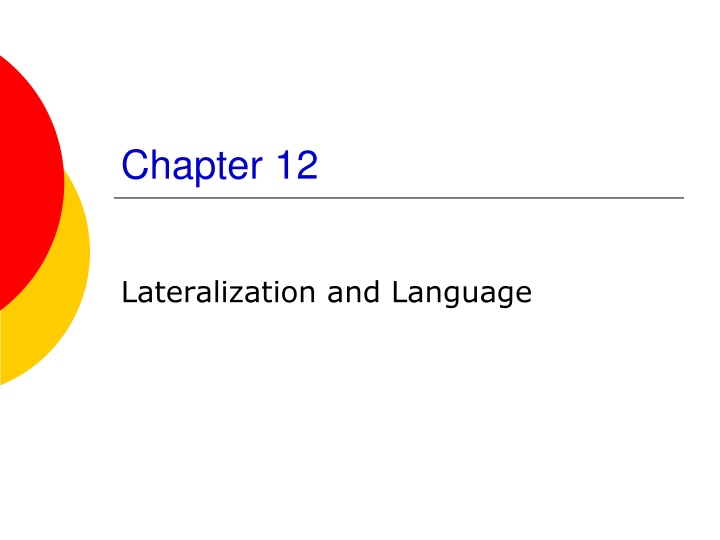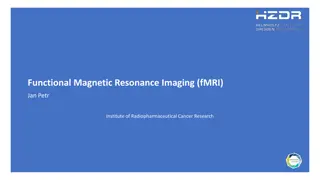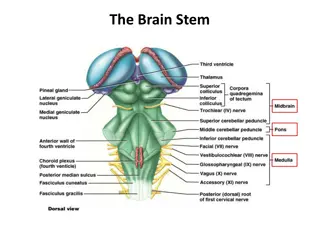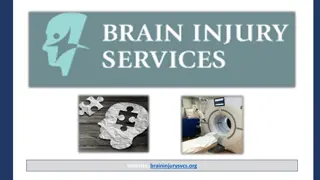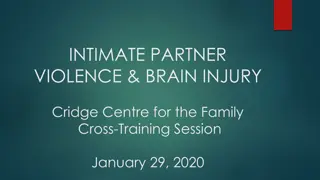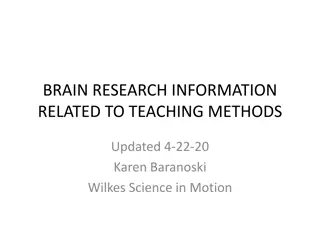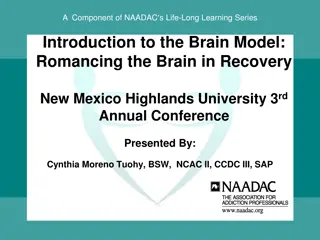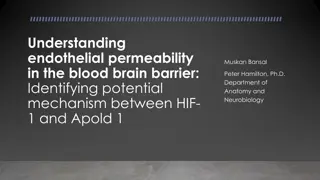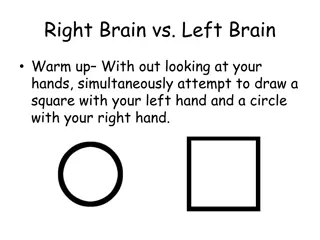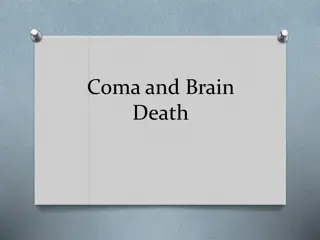Hemispheric Lateralization and Language: Understanding Brain Specialization
In this information-rich content, explore the fascinating world of hemispheric lateralization and its impact on language processing. Discover why hemispheric specialization exists, the role of genetics in handedness, insights from split-brain studies, the structure of language, and the involvement of the right hemisphere in language functions. Dive into the debate on whether language is innate or learned, touching on Noam Chomsky's Language Acquisition Device (LAD) and the implications of hemisphere removal on language development.
Download Presentation

Please find below an Image/Link to download the presentation.
The content on the website is provided AS IS for your information and personal use only. It may not be sold, licensed, or shared on other websites without obtaining consent from the author.If you encounter any issues during the download, it is possible that the publisher has removed the file from their server.
You are allowed to download the files provided on this website for personal or commercial use, subject to the condition that they are used lawfully. All files are the property of their respective owners.
The content on the website is provided AS IS for your information and personal use only. It may not be sold, licensed, or shared on other websites without obtaining consent from the author.
E N D
Presentation Transcript
Chapter 12 Lateralization and Language
Why does hemispheric lateralization exist? Left hemisphere Language grammar and vocabulary Logical, analytical thinking Right hemisphere Intonation and accentuation Emotional aspects of language Spatial manipulation, facial comprehension and creative abilities Two hemispheres are differently specialized in the processing of segmental features of language
Handedness 90% right handed 70% of left handed are left hemisphere dominant for language Genetics important factor
Split-brain patients Commissurotomy section of corpus callosum Behave as if 2 brains Humans to control spread of seizures
Split-brain studies with humans Left hemisphere language & analytical functions Right hemisphere non-verbal & visual-spatial functions Left-hemisphere dominance of language With tachistoscope presentation of stimuli Could not verbally name stimuli in left field Ability to name objects left hemisphere
The structure of language Morphology the rules for combining words to make longer words are specified by morphology, the addition of suffixes and prefixes Phonology dictates the regulations involved when sound elements and phonemes are combined in order to form words Prosody consists of the arrangement of intonation and stress which, for instance, lets us recognize questions from statements Syntax dictates the way in which words combine to make phrases and sentences in order to make the meaning clear
Involvement of the right hemisphere in language Prosody Prosody of language refers to the pitch, volume, rate and tempo of speech (Pell, 2006) Disorder termed aprosodia
Is language innate or do we learn it? Noam Chomsky Language Acquisition Devise (LAD) If left hemisphere is removed as an infant, language functions will develop entirely within the right hemisphere From nurture standpoint, there appears to be a critical period for language acquisition
When was language first produced? The use of language may have started as far back as 2 million years ago (Corballis, 2009) The recent discovery of the FOXP2 gene The FOX2P gene is necessary for speech and it has a role to play in our fine motor control FOX2P the language gene ????
Speech production Broca (1861) Man named Leborgne, who comprehended language but was unable to produce speech He could only produce a single repetitive syllable, tan Leborgne died of his ailments several days later The area that was damaged in Leborgne is now known as Broca's area Broca s aphasia
Broca aphasia Non-fluent aphasia Damage to anterior areas of the brain, including but not limited to the left posterior inferior frontal gyrus called Broca's area (Brodmann area 44 and Brodmann area 45) Most common cause of Broca's aphasia is the result of a stroke
Wernickes aphasia Wernicke s area Damage to this area results in a person not being able to understand language instead of not being able to speak Lesions in Wernicke s aphasia are traditionally located as the posterior section of the superior temporal gyrus (STG) in the left cerebral hemisphere Brodmann area 22
Lateralization of brain function Individuals with Wernicke s aphasia can speak fluently with usual grammar, syntax, intonation and stress However, their language content is less meaningful Paragrammatical speech substitution of verb tenses or have difficulty using the correct pronoun or preposition Generally as a result of a stroke
The WernickeGeschwind model Listening auditory pathways to the primary auditory cortex and on to Wernicke s area Speaking Wernicke s area to Broca s area, to the facial area of the motor cortex, and on to the facial motor neurons in the brainstem Reading visual areas 17, 18 and 19 to the angular gyrus and on to Wernicke s area, for silent reading or, in conjunction with Broca s area, for reading out loud
The bilingual brain Central issue whether two different languages are localized in the same area or in distinct areas of the brain No laterality differences have been found between monolingual speakers and bilingual speakers Minimal differences in first or second languages localization Particularly in early speaker of second languages
Communicative disorders: the aphasias Acquired language impairment Non-fluent aphasias Broca s aphasia Broca s area damaged Inability to initiate well-articulated conversational speech Speech comprehension is intact Global aphasia severe depression of all language function Transcortical motor aphasia Not prone to speak Speech is non-fluent and agrammatical Good comprehension
Fluent aphasias Wernicke s aphasia Wernicke s area damaged Speaks fluently but impaired meaningfulness Paragrammatic speech use of inappropriate morphemes Conduction aphasia arcuate fasciculus damage Accurate repetition of short phases Phonemic paraphasia may be present Comprehension and conversational speech may be good Pathophysiology of conduction aphasia remains elusive (Bernal & Ardila, 2009) Transcortical sensory aphasia echolalia
Other communicative disorders Apraxia of speech due to impaired motor control Often associated with Broca s aphasia Genetic factors playing a role in the disorder (Shriberg et al., 1997) Auditory-verbal agnosia Unable to recognize speech as meaningful Visual-verbal agnosia problem with printed words Patients with lesions deep in the left temporal lobe (Gazzaniga et al., 1973)
Reading Very little conscious effort (Bashir & Hook, 2009) Imaging studies suggest it starts with activation in pathways that link the primary visual cortex to the posterior inferior temporal cortex (PITC) Whole word reading seems to follow the ventral or what stream to the fusiform gyrus Phonological reading appears to follow the dorsal or where stream to the temporoparietal cortex
Writing The motor aspects of writing are controlled by the motor cortex with dorsal parietal lobe and the premotor cortex Evidence also that the left superior parietal lobe is essential for writing (Menon & Desmond, 2001) Writing involves the posterior inferior temporal cortex (PITC) (Nakamura et al., 2000) Unable to spell out words phonetically is called phonological dysgraphia and results from damage to superior temporal lobe Damage to the inferior parietal lobe causes a condition called orthographic dysgraphia or the inability to spell whole words
Disorders of reading and writing Alexia and agraphia Alexia an inability to read Agraphia an inability to write Alexia without agraphia is sometimes referred to as pure alexia Alexia with agraphia results from damage to the angular gyrus itself and renders the patient unable to read and write (Sakurai et al., 2010)
Disorders of reading and writing Dysgraphia difficulty writing Orthographic dysgraphia difficulty in using visually based writing and difficulties spelling irregular words Phonological dysgraphia can write familiar words but has difficulty writing out unfamiliar words Orthographic dysgraphia results from damage to the inferior parietal lobe Phonological dysgraphia is associated with damage to the superior temporal lobe
Dyslexia Commonly called developmental dyslexia Defined as an inconsistency between the ability to read and basic intellectual skills in children Estimates of the population that it affects range from 10 to 30% 4 main theories
Dyslexia phonological theory Specifically impaired when attempting to represent, store and/or retrieve word sounds Grapheme-phoneme correspondence Neurologically, it is commonly believed that the disorder is caused by a congenital malfunction of left-hemisphere peri-sylvian brain areas (Beland & Mimouni, 2001)
Dyslexia visual theory Visual disorder that makes it difficult to process alphabetical letters Magnocellular pathway is selectively disrupted (Stein & Walsh, 1997) Deficiencies in visual processing, and to abnormal binocular control Individuals demonstrate abnormalities in their magnocellular layers of the lateral geniculate nucleus (Livingstone et al. 1991) A phonological deficiency is not ruled out with the visual theory
Dyslexia cerebellar theory Cerebellum of a dyslexic is slightly dysfunctional, resulting in several cognitive deficits (Nicolson et al., 2001) Observations of insufficient dyslexic performance in several automized and implicit motor tasks (Barnes et al., 2007) Differences in grey matter volume (Pernet et al., 2009)
Dyslexia unified theory Theory that unifies and tries to combine all of the research information that was previously mentioned Magnocellular dysfunction is not simply restricted to the visual pathways Generalized to all modalities Cerebellum is given tremendous information from a variety of magnocellular systems located in the brain Tries to accounts for every known symptom of dyslexia
Readings Barnes, J. (2011). Essential Biological Psychology (Chapter 12). London: Sage. The Essentials Chomsky, N. (1986). Knowledge of Language: Its Nature, Origin and Use. New York: Praeger. Next Steps Corballis, M.C. (2009). The evolution of language. Annals of the New York Academy of Sciences, 1156, 19-43. Delving Deeper Nicolson, R.I., Fawcett, A.J., & Dean, P. (2001). Dyslexia, development and the cerebellum. Trends in Neurosciences, 24(9), 515-516.
